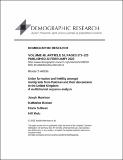Files in this item
Union formation and fertility amongst immigrants from Pakistan and their descendants in the United Kingdom : a multichannel sequence analysis
Item metadata
| dc.contributor.author | Harrison, Joseph | |
| dc.contributor.author | Keenan, Katherine | |
| dc.contributor.author | Sullivan, Frank | |
| dc.contributor.author | Kulu, Hill | |
| dc.date.accessioned | 2023-05-04T11:30:10Z | |
| dc.date.available | 2023-05-04T11:30:10Z | |
| dc.date.issued | 2023-02-22 | |
| dc.identifier | 283483912 | |
| dc.identifier | 5db5f647-d007-4c7f-beb8-1dc7f87dc58f | |
| dc.identifier | 85150784636 | |
| dc.identifier | 85150784636 | |
| dc.identifier.citation | Harrison , J , Keenan , K , Sullivan , F & Kulu , H 2023 , ' Union formation and fertility amongst immigrants from Pakistan and their descendants in the United Kingdom : a multichannel sequence analysis ' , Demographic Research , vol. 48 , 10 , pp. 271–320 . https://doi.org/10.4054/DemRes.2023.48.10 | en |
| dc.identifier.issn | 1435-9871 | |
| dc.identifier.other | ORCID: /0000-0001-6750-6004/work/129708376 | |
| dc.identifier.other | ORCID: /0000-0001-8808-0719/work/129708877 | |
| dc.identifier.other | ORCID: /0000-0002-6623-4964/work/129709240 | |
| dc.identifier.other | ORCID: /0000-0002-9670-1607/work/129709187 | |
| dc.identifier.uri | https://hdl.handle.net/10023/27510 | |
| dc.description | Funding: European Research Council (ERC) under the European Union’s Horizon 2020 research and innovation programme (Grant agreement No. 834103). | en |
| dc.description.abstract | Background : Previous work identifies conservative family behaviour amongst Pakistanis in the United Kingdom relative to natives, including earlier marriages, fewer dissolutions, and higher fertility. However, few studies have investigated how fertility and partnership are intertwined and interdependent. Objective : Our aims are, first, to identify differences between the family trajectories of Pakistanis and natives and, second, to determine if patterns are consistent across immigrant generations. Finally, we aim to identify how family trajectories vary across birth cohorts and education levels. Methods : We apply multichannel sequence analysis (MCSA) to data from the UK Household Longitudinal Study. We first use clustering methods to group similar individuals and then apply multinomial logistic regression to calculate the probability of belonging to a cluster based on individual characteristics. Results : The Pakistani population exhibits a higher likelihood of entering a direct marriage and having large families compared to natives. Cohabitation is rare amongst Pakistani population. These patterns have changed little between immigrant generations. Degree-level education is associated with a higher likelihood of adopting behaviours typical to ancestral natives; however, the effects are not large enough to indicate convergence. Contribution : We demonstrate the need to investigate partnership and fertility trajectories simultaneously and show the value of MCSA for identifying differences between migrant groups. The results improve our understanding of family formation patterns of Pakistani immigrants and their descendants in the United Kingdom. | |
| dc.format.extent | 50 | |
| dc.format.extent | 1036815 | |
| dc.language.iso | eng | |
| dc.relation.ispartof | Demographic Research | en |
| dc.subject | Assimilation | en |
| dc.subject | Fertility | en |
| dc.subject | Life course | en |
| dc.subject | Migrants | en |
| dc.subject | Sequence analysis | en |
| dc.subject | Union formation | en |
| dc.subject | United Kingdom | en |
| dc.subject | HT Communities. Classes. Races | en |
| dc.subject | DA Great Britain | en |
| dc.subject | Demography | en |
| dc.subject | 3rd-DAS | en |
| dc.subject | AC | en |
| dc.subject | MCC | en |
| dc.subject.lcc | HT | en |
| dc.subject.lcc | DA | en |
| dc.title | Union formation and fertility amongst immigrants from Pakistan and their descendants in the United Kingdom : a multichannel sequence analysis | en |
| dc.type | Journal article | en |
| dc.contributor.sponsor | European Research Council | en |
| dc.contributor.institution | University of St Andrews. School of Geography & Sustainable Development | en |
| dc.contributor.institution | University of St Andrews. Population and Behavioural Science Division | en |
| dc.contributor.institution | University of St Andrews. School of Medicine | en |
| dc.contributor.institution | University of St Andrews. Sir James Mackenzie Institute for Early Diagnosis | en |
| dc.contributor.institution | University of St Andrews. Population and Health Research | en |
| dc.identifier.doi | https://doi.org/10.4054/DemRes.2023.48.10 | |
| dc.description.status | Peer reviewed | en |
| dc.identifier.grantnumber | 834103 | en |
This item appears in the following Collection(s)
Items in the St Andrews Research Repository are protected by copyright, with all rights reserved, unless otherwise indicated.

